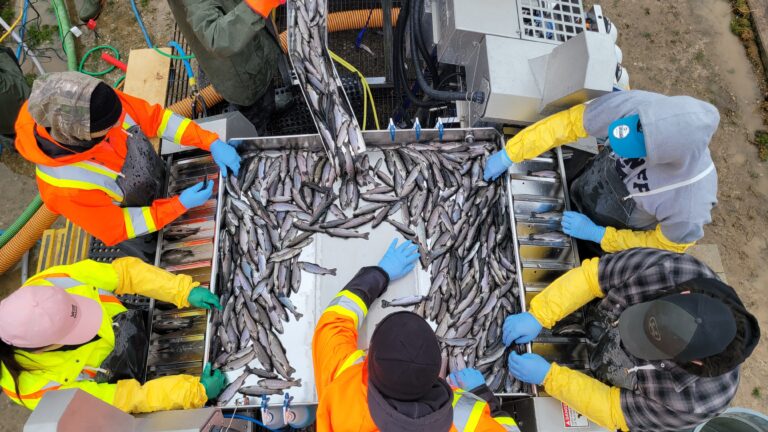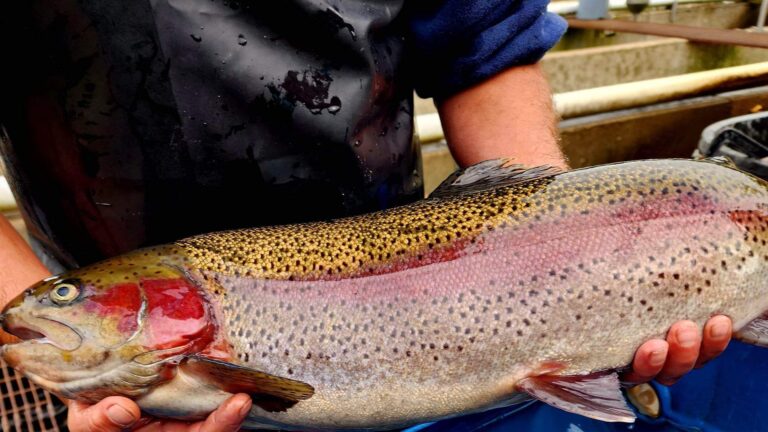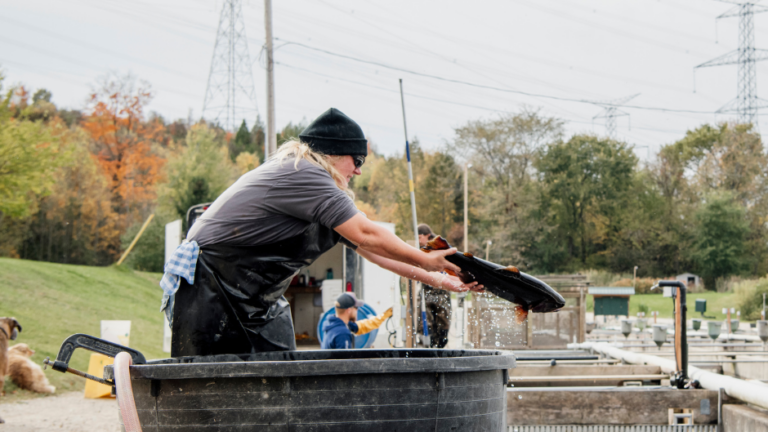
I’ve been getting some emails recently from customers concerned that we’re now raising rainbow trout in open-water pens on Manitoulin Island.
We know there are some bad net-pen farms in the world. And sadly, they are the only farms that seem to get the media attention.
Farmers have been raising fish in net-pens in Ontario for over 40 years. In the beginning, there were a few mistakes while the government and farmers learned good lessons on where to locate farms.
But since then, we have decades of scientific studies in Ontario that have NOT found any negative impacts from the farms.
In fact, there are repeated studies that show these farms can be GOOD for the ecosystem. They’re linked to increases in wild fish populations and greater biodiversity. The story is so good that, yes, it’s pretty unbelievable!
Here’s a summary of that research:
1. Added nutrients aren’t a bad thing
Lake Huron is very low in nutrients, mostly because of invasive species like zebra mussels. It doesn’t have enough to support a healthy ecosystem, and that causes reductions in preyfish and biodiversity. A 2020 study for the International Joint Commission called it a “biological desert”.
What can introduce nutrients and kickstart those ecosystems? You guessed it, a fish farm!
2. The nutrients from fish farms enhance the ecosystem and boost wild stocks
Scientists at Fisheries and Oceans Canada set up a net-pen farm in the Experimental Lakes Area to understand impacts. They did 8 years of pre-assessment, operated the farm for 5 years, and then took the farm away and did 8 more years of post-assessment.
They showed that lake trout populations doubled after five years of a farm operating in an experimental lake similar to Lake Huron. And that benefit disappeared within 2 years of the farm not operating anymore.
The only negative impact was the white suckerfish declined slightly because the lake trout eat them. See the full study in the journal Freshwater Biology.
3. Continued research proves the case
Because that study above was in a “laboratory-like” lake, scientist Neil Rooney from University of Guelph wanted to understand what happens around the actual farms in Lake Huron.
His team analyzed stable isotope and fatty acid signatures (referred to as biotracers) in the wild fish to look for evidence that these fish ultimately benefit from aquaculture inputs around farms in Lake Huron. They came to similar conclusions that fish farms could have a positive effect on local fish communities.
“Like the Experimental Lakes Area study, our biotracer analysis supports the hypothesis that local wild fish, especially pelagic fish such as cisco and lake trout, could benefit from the presence of fish farms by incorporating excess feed into their diets,” said Dr. Neil Rooney, from U of G’s School of Environmental Sciences. “The strongest evidence of these energetic subsidies was found in Parry Sound, whereas signals were weaker around the North Channel operations.”
4. Freshwater fish farms don’t have sea lice or federally reportable diseases
If you’ve heard about sea-lice, we don’t have it in the fresh waters of Ontario. We also don’t have any major viruses or other diseases that transfer between wild and farmed fish, partly because it gets so cold nothing survives here!
5. We farm the same fish that are released into the wild
If you’re worried about genetic mixing in the case of very very rare escapes. The good news is the rainbow trout we’re raising on farms are the same genetics that community hatcheries and the Ontario government release in Ontario waters.
These groups release approximately 1 million rainbow trout every year. See more about restocking in Ontario.
It doesn’t mean we should put fish farms everywhere
All this said, we don’t encourage putting fish farms everywhere, or put as much nutrients as we can into the lake. It’s important that we don’t overload nutrients in one place, such as a bay with little water exchange, as that can that can cause nuisance algae.
This is why we do such rigorous water testing, and also why regulators ask for plenty of environmental testing before a new farm goes in.
Why we expanded to Manitoulin Island
Some of you have been asking why we’d expand to Manitoulin.
The economics of raising fish at small land-based farms is very challenging. There used to be about 140 farms like ours in Ontario, and now there are less than 15.
On these farms, we’re greatly limited by how much water we have. At a net-pen farm, the overall cost of production is nearly two thirds less because (i) we use much less hydro, (ii) we need less people needed to continually clean, grade and move fish, and (iii) the increased water increases their feed efficiency.
We also got passed over time and time again by any larger retailers because we just don’t have enough supply to compete in today’s marketplace.
We didn’t take the step lightly into net-pen farming. Between Arlen and I, we must have had three dozen conversations with scientists and regulators to understand these previous studies and all the environmental work that was done around this new net-pen farm.
We would only make this step if we were confident we could operate at the same level of environmental sustainability as we have with our land-based farms for almost 30 years.
Plus now we hear from our friends at Sheshegwaning First Nation that folks are catching types of fish in our surrounding bay that they haven’t seen in 10 years!
—RJ


